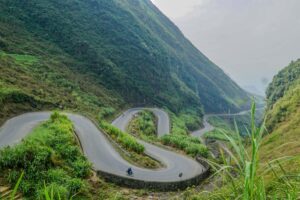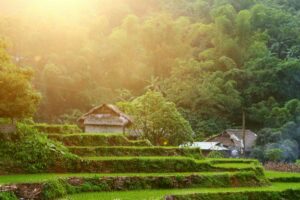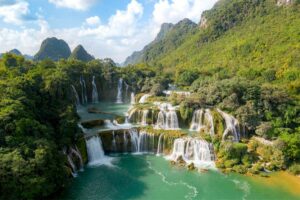Traveling in Vietnam rainy season can be a unique and rewarding experience. The country transforms into a lush, vibrant landscape with fewer tourists and cheaper prices. While the rain can be heavy at times, it doesn’t necessarily mean your trip will be a washout. With the right planning and flexibility, you can still enjoy many incredible activities and sights throughout the country.
When is rainy season in Vietnam?
The rainy season in Vietnam varies depending on the region. Understanding when and where it rains the most can help you plan your trip more effectively.
- Northern Vietnam: The rainy season in the north lasts from May to September, with June and July being the wettest months. Despite the rain, temperatures remain warm, often reaching up to 30°C (86°F). The summer months also have the most sunshine hours, so you can still enjoy plenty of sunny days.
- Central Vietnam: Central Vietnam’s rainy season starts later, typically from September to December. The worst months are October and November, with frequent heavy rains and potential flooding, especially in low-lying areas like Hoi An and Hue. Temperatures remain warm throughout the season.
- Southern Vietnam: The south experiences its rainy season from May to November, with June to August being the wettest months. It rains almost daily, usually in short, intense bursts in the afternoon, which quickly clear up. Temperatures are consistently warm, ranging from 25°C to 35°C (77°F to 95°F).
What to expect: Does it rain all day?
A big misconception is that the rainy season in Vietnam means it rains all day, every day. This also depends a lot on the region.
Southern Vietnam: It rains almost every day, but often only for one or two hours in the afternoon. These heavy downpours can cause streets to flood but also cool the temperature to a more pleasant level.
Northern Vietnam: The weather is more changeable. Some days it rains a lot, while on others, it only rains for a short while. The rainy season in the north, which coincides with summer, actually has the most sun hours of the year. So, you can expect to see more sun during the rainy season than during the dry winter season.
Central Vietnam: In central Vietnam, rains can be heavier and longer, especially during October and November.
Pro’s & cons for traveling during rainy season in Vietnam
Traveling during the rainy season in Vietnam has its advantages and disadvantages. Here’s what you need to know.
Pro’s
- Beautiful landscapes: The rice fields are at their greenest, the waterfalls are at their most spectacular, and the forests and jungles are lush and vibrant.
- Cheaper: Many hotels and tours offer discounts during the rainy season, making it a more affordable time to visit.
- Less tourists: With fewer travelers around, you can enjoy popular sites and attractions without the usual crowds.
- Cleaner air: The rain helps to clear the air of dust and pollution, making it fresher and more pleasant.
Cons
- No beach weather: It’s not recommended to visit the beaches during the rainy season as the weather can be unpredictable and the sea rough.
- Remote mountain regions are more dangerous: Landslides are more common during the rainy season, making travel in mountainous areas riskier.
- Flooding in streets: Cities like Ho Chi Minh City, Hanoi, Hoi An, and Hue can experience street flooding during heavy rains. These floods often disappear after a few hours, but they can disrupt travel plans.
- Higher humidity levels: The increased humidity can make the weather feel hotter and more uncomfortable.
Tips for traveling rainy season in Vietnam
While the rainy season presents some challenges, a few simple tips can ensure a smooth and enjoyable trip:
Don’t be afraid to get a little wet:
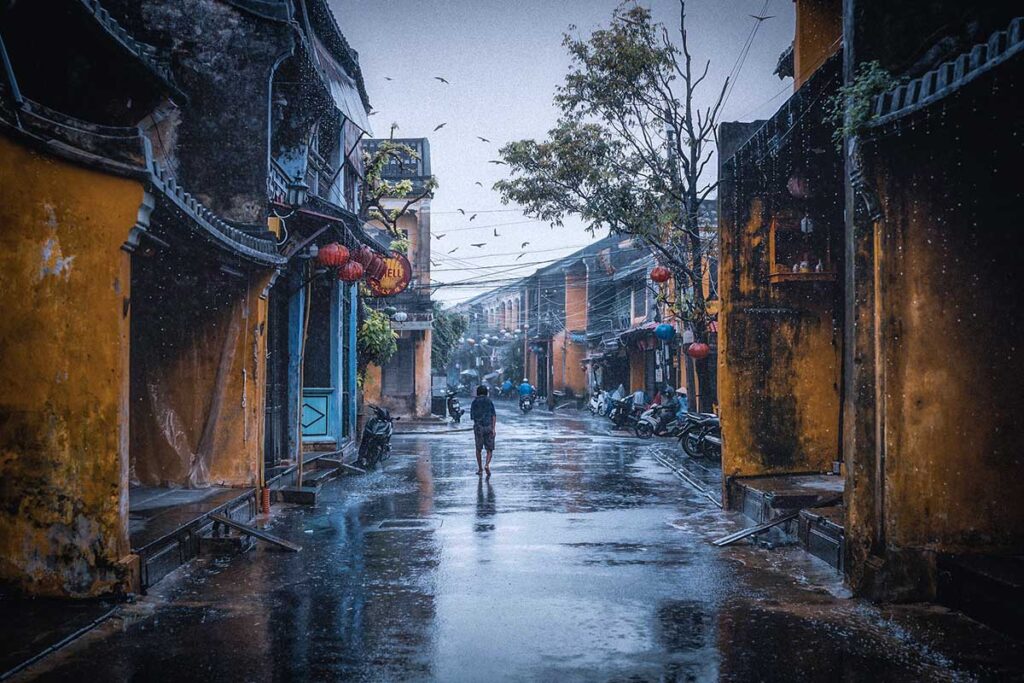
It’s all part of the experience! The rain often comes and goes quickly, leaving behind clean, fresh air and a cooler temperature. Embrace the showers and let them add a touch of adventure to your trip.
Choose car over motorbike

Sightseeing by motorbike, either on the back of a motorbike or driving yourself, is an amazing adventure and offers a feeling of freedom. However, if the weather looks bad, it’s better to choose a private car with a driver. You’ll be comfortably protected against the rain, and on non-rainy days, you’ll stay cool with air conditioning.
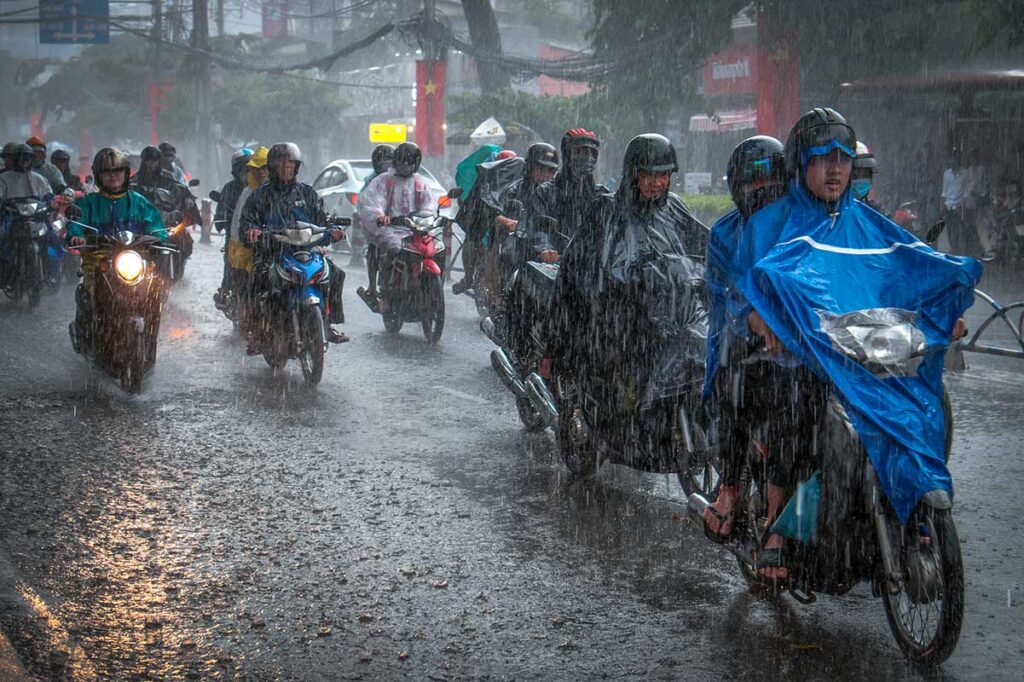
Finding a beach destination during rainy season
When traveling during the rainy season in northern and southern Vietnam, remember that central Vietnam’s rainy season starts later. If you travel in June, July, and August, you can often still enjoy the beaches of Da Nang, Hoi An, and Nha Trang.
Protect your luggage and valuables
Protect your belongings, especially electronics, by investing in waterproof bags. You can also get rain covers for your backpack if you travel with one.
Check weather forecast
Always check the weather forecast for typhoons. A few times a year, a typhoon can hit parts of Vietnam, mostly in central or northern Vietnam.
Doing laundry service during your trip
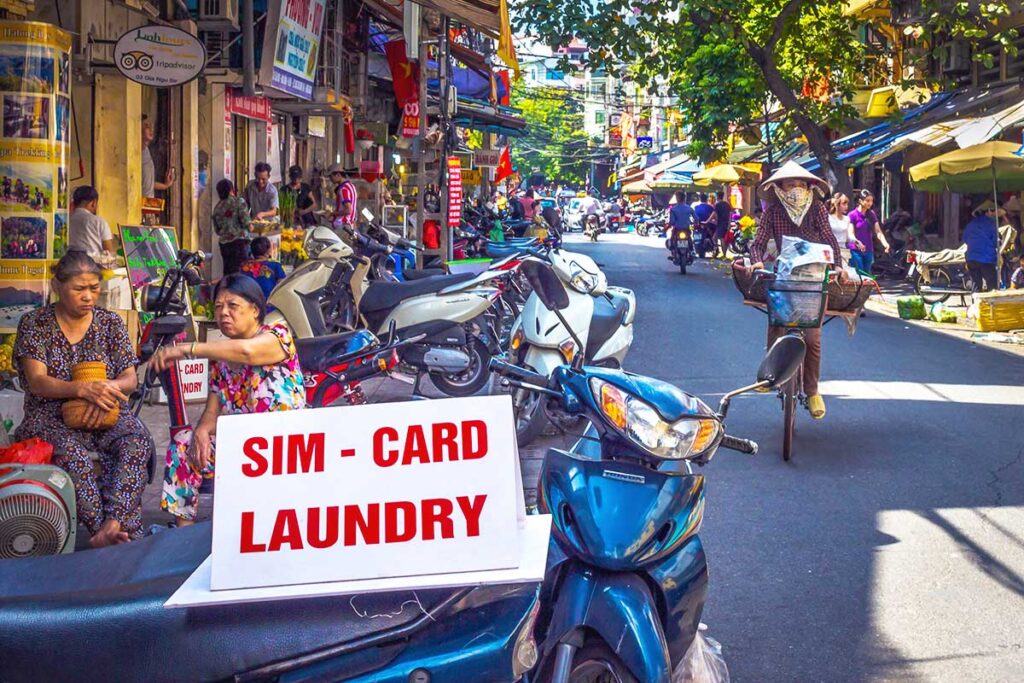
Vietnam has plenty of affordable laundry services, often costing around a dollar per kilo. During the rainy season, you might go through clothes quickly due to the heat and rain. Instead of bringing bulky luggage, use these laundry services; they usually complete the job in 24 hours, and some even offer same-day express service.
Use taxi’s and Grab
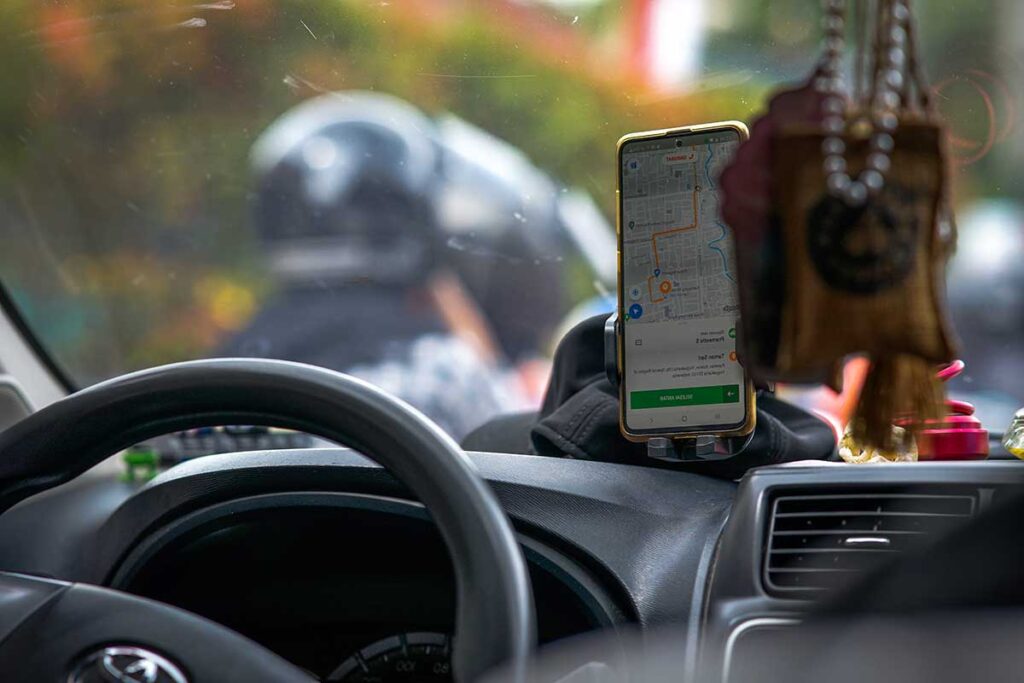
One advantage of traveling in Vietnam is the affordability. If it’s raining hard and you need to go somewhere, just use a taxi. For short distances, it often costs only 2 or 3 dollars. You can also use Grab, a service similar to Uber, where you select your pick-up and drop-off locations and see the price upfront.
Start your day early to make the most of the dry mornings
Maximize your outdoor activities by starting your day early when it’s typically drier. This allows you to explore more before the afternoon rains.
Booking the right accommodation
- Choose accommodations close to nearby attractions so you don’t have to walk far when it rains.
- Look for facilities that are nice on rainy days, such as massages or a indoor pool.
- Opt for accommodations with amazing views, so you don’t even need to leave.
- Ensure the accommodation has a restaurant, so in case of very bad weather, you can dine at the hotel.
What to pack for rainy season
Packing for the rainy season in Vietnam requires some additional items to ensure you stay comfortable and dry. For a complete packing list, check out our other blog post.
Light rain jacket
The weather is hot, so bring a lightweight jacket that’s easy to pack in your day backpack. Since it doesn’t rain all day, you’ll want a jacket you can quickly put on and take off.
Waterproof day backpack
Keep all your valuables dry by using a waterproof day backpack.
Waterproof walking shoes
While many people use flip-flops in Vietnamese cities, they offer less grip and can quickly get your feet dirty. Waterproof walking shoes are a better option, especially if you plan on trekking.
Light clothes
The rainy season coincides with summer, so bring light, breathable clothes to stay cool in the hot weather.
Mosquito repellent
Essential for keeping mosquitoes at bay, especially in humid and wet conditions.
Quick-dry towel
A quick-dry towel is useful for unexpected showers and stays dry much faster than a regular towel.
Waterproof phone case
Protect your phone from water damage with a waterproof phone case.
Compact travel umbrella
A small, travel-sized umbrella can be a lifesaver during sudden downpours.
17 best things to in Vietnam’s rainy season
Cool and unique outdoor experiences
Some of the best scenery in Vietnam can be experienced during the rainy season. The lush landscapes come alive, offering breathtaking views and vibrant greenery.
1. The terraced rice fields of Northern Vietnam
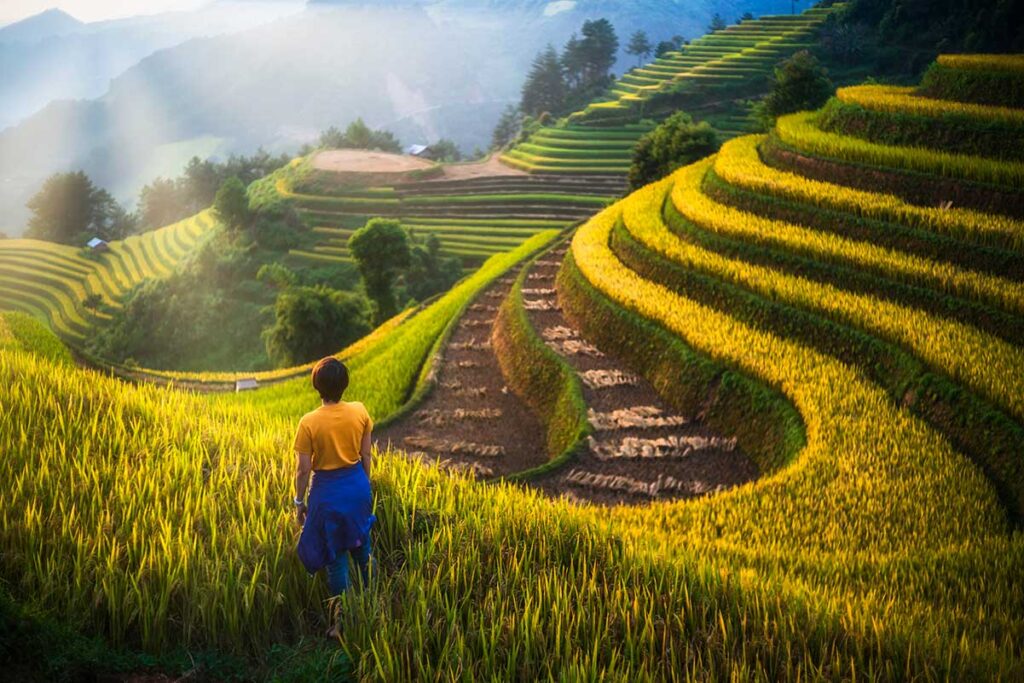
The rainy season is the only time to see the terraced rice fields in their full glory in places like Sapa and Mu Cang Chai. The fields are lush and green, creating a stunning patchwork of terraces cascading down the mountains. This is the perfect time for photography and trekking through these iconic landscapes.
2. Exploring Vietnam’s waterfalls
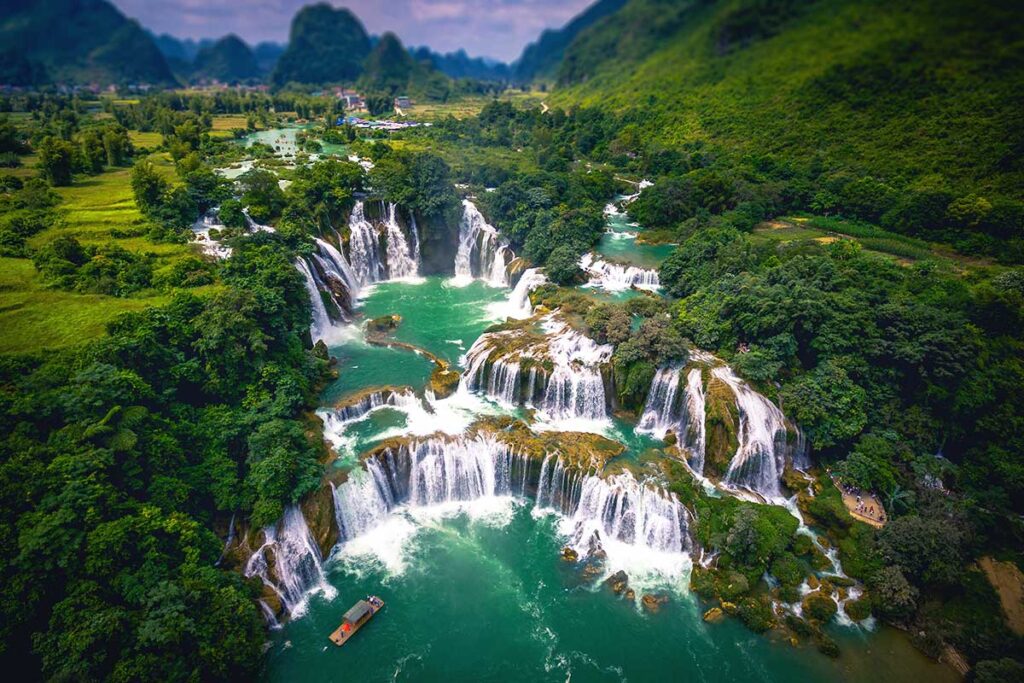
More rain means more water, resulting in spectacular waterfalls. Examples include the majestic Ban Gioc Waterfall, the largest in Vietnam, and Pongour Waterfall in the Central Highlands. These falls are at their most powerful and beautiful during the rainy season, providing a magnificent sight.
3. Experience the floating markets in the Mekong Delta
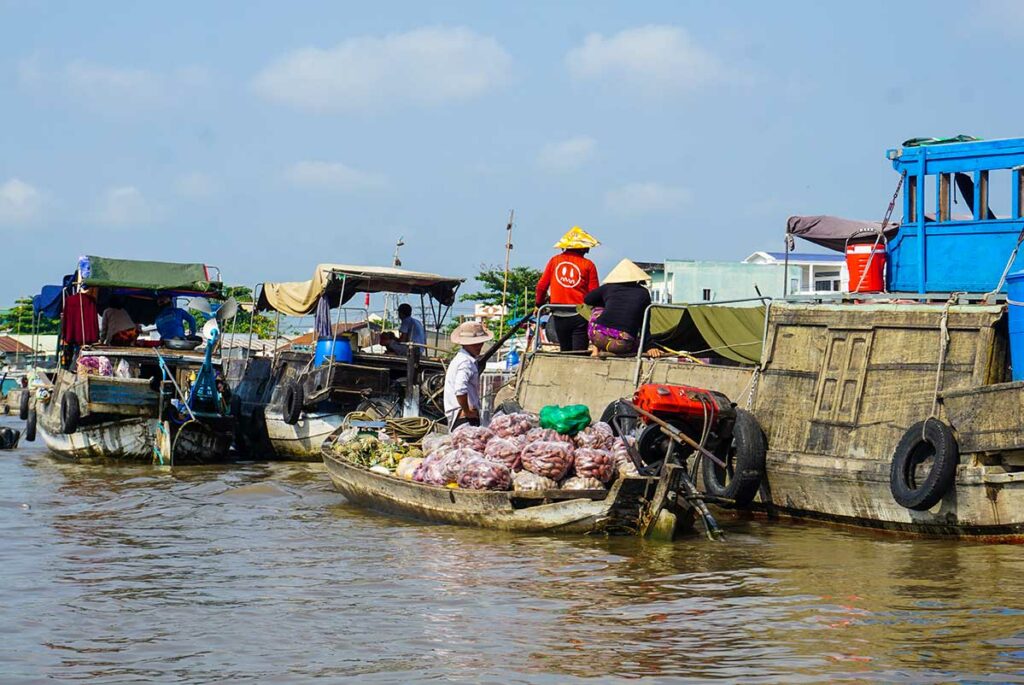
The floating markets in the Mekong Delta are a unique cultural experience, especially vibrant during the rainy season. The waterways are fuller, making the markets even livelier. You can witness locals trading fresh produce and goods from their boats, providing a fascinating insight into daily life in the Delta.
4. Sightseeing the natural & cultural highlights of Ninh Binh

Also Ninh Binh has during rainy season the best time to see the rice fields and the green jungles of Cuc Phuong National Park. Besides that there is so much to do and Ninh Binh is a easy to explore by yourself region, so you can make a very flexible itinerary, go out to see things when it is dry and relax at a stunning lodge or resort when it rains.
Enjoying central Vietnam during northern and southern rainy seasons
When traveling during the rainy season in the north and south, central Vietnam offers a great escape. The central region’s rainy season starts later, so if you visit in June, July, or August, you can enjoy sunny weather and explore its rich history, beautiful beaches, and stunning landscapes.
5. Explore the ancient town of Hoi An
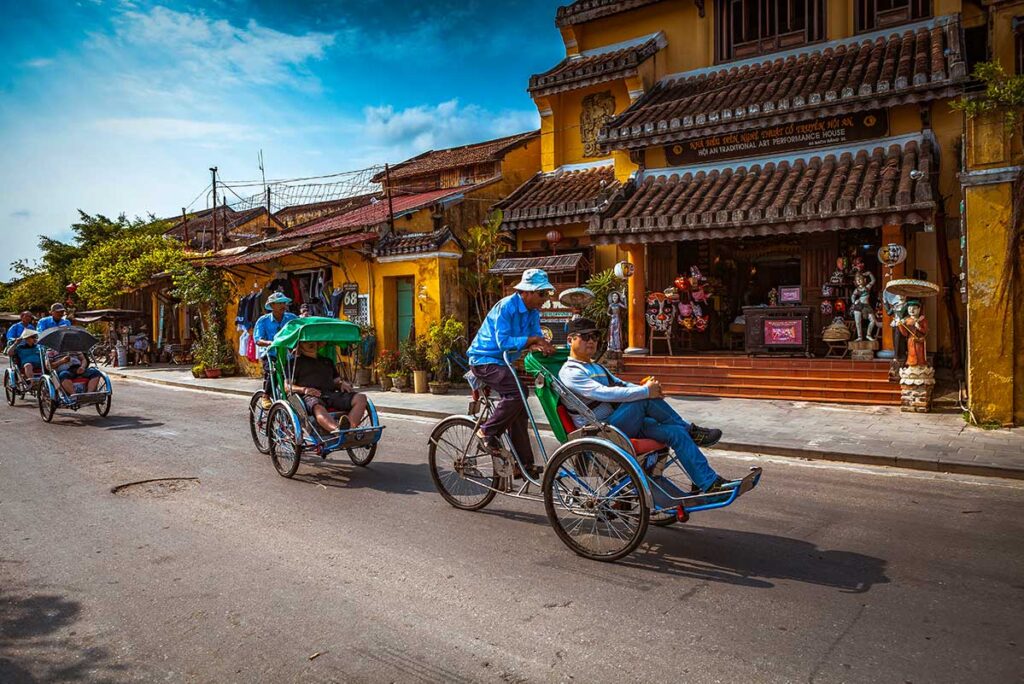
Hoi An is a charming town known for its well-preserved architecture, lantern-lit streets, and vibrant markets. During the dry months of central Vietnam, you can wander through the ancient town, take a boat ride on the Thu Bon River, and enjoy the local cuisine without worrying about the rain.
6. Relax on the beaches of Central Vietnam
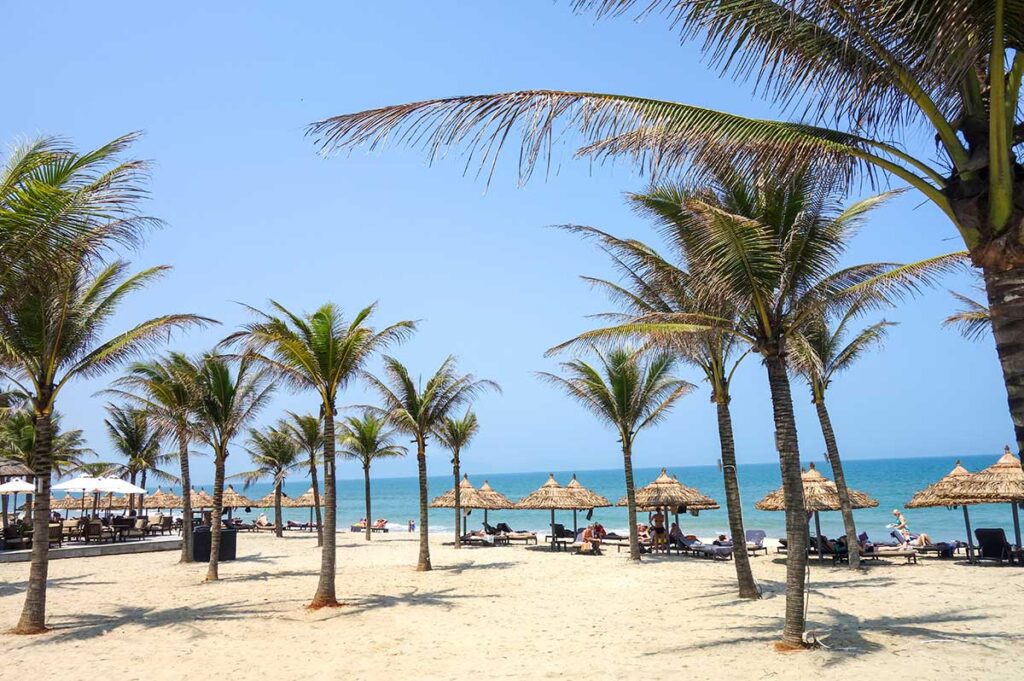
Central Vietnam boasts some of the most beautiful beaches in the country, such as An Bang Beach and My Khe Beach. During the dry months, these beaches offer perfect conditions for sunbathing, swimming, and water sports. The serene environment and fewer crowds make for an ideal beach getaway.
7. Visit the temples in Hue
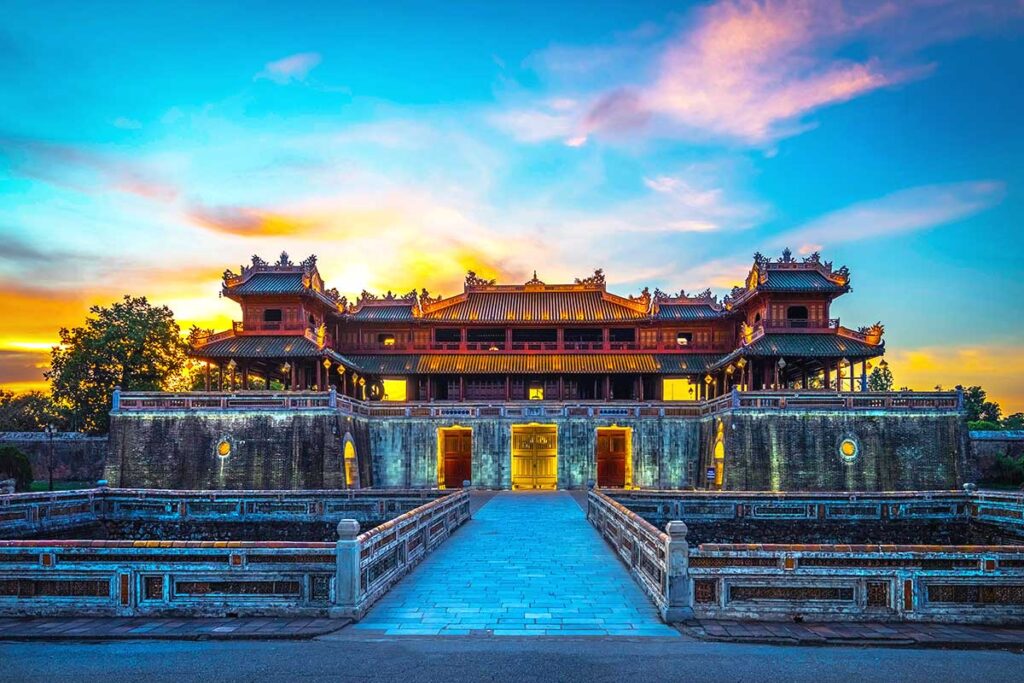
Hue, the former imperial capital, is home to many historic temples and pagodas. You can explore the Imperial City, the Thien Mu Pagoda, and the royal tombs without the interference of rain. The dry weather in central Vietnam during the summer months provides a comfortable environment for sightseeing.
8. Discover the caves in Phong Nha-Ke Bang National Park
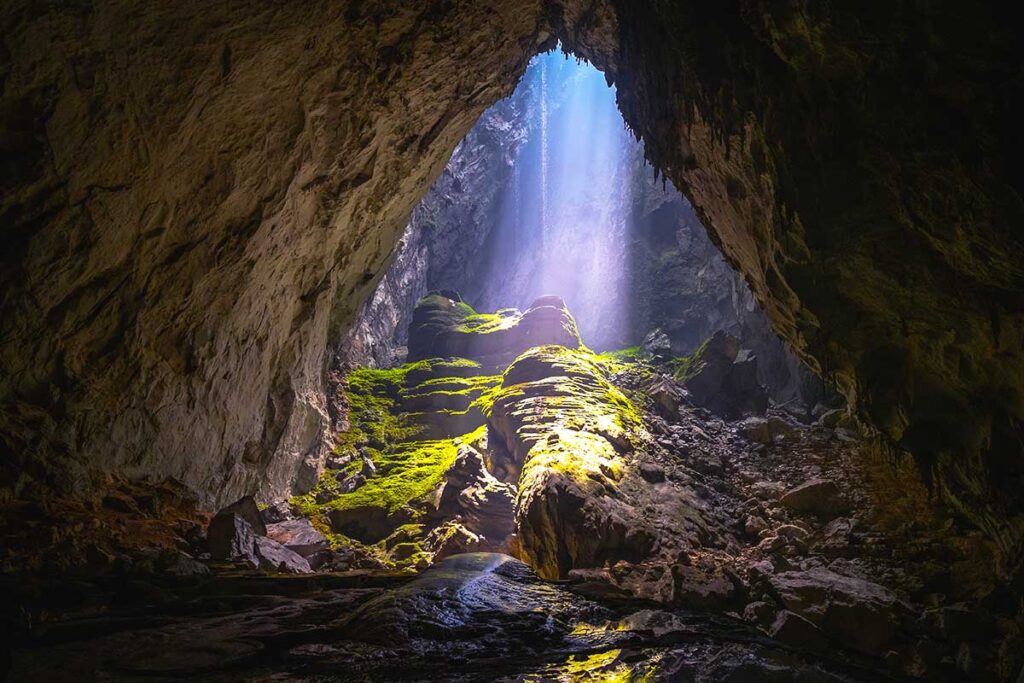
Phong Nha-Ke Bang National Park is famous for its spectacular caves, including Son Doong, the largest cave in the world. The dry months are perfect for exploring these caves, as the weather is more favorable for trekking and caving adventures. The park also offers stunning jungle landscapes and rivers to explore.
9. Visiting the My Son Sanctuary
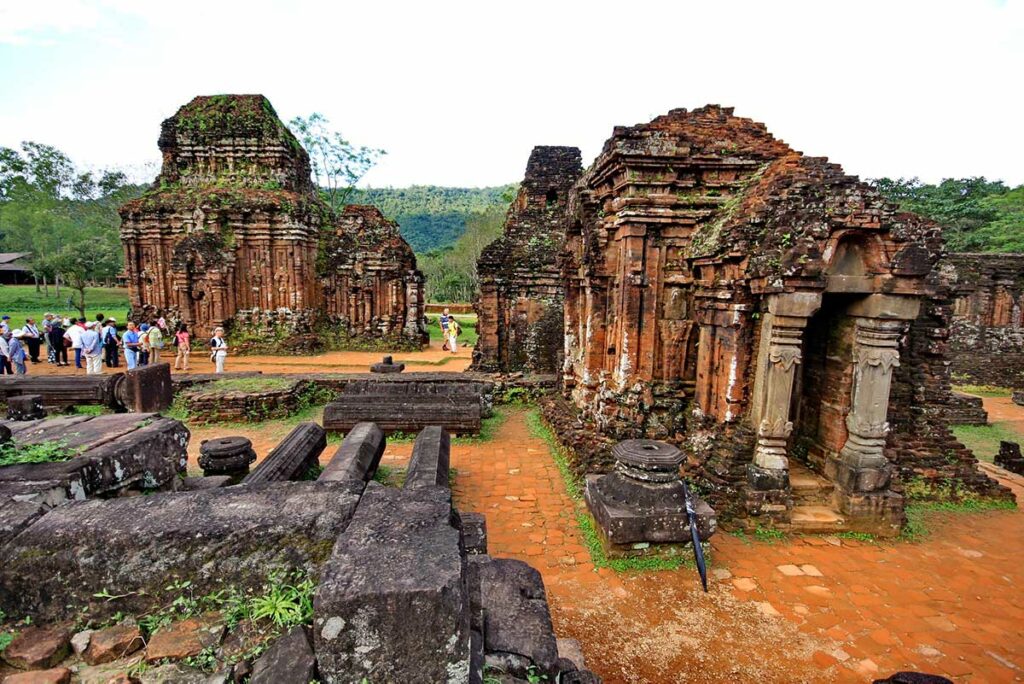
My Son Sanctuary is a cluster of abandoned and partially ruined Hindu temples in central Vietnam. The site is a UNESCO World Heritage site and offers a fascinating glimpse into the ancient Champa civilization. The summer months are perfect for exploring this historical site.
10. Diving in Nha Trang

Nha Trang is a coastal city known for its diving spots, offering clear waters and vibrant marine life. The Hon Mun Marine Protected Area is a popular site for divers, with its coral reefs and diverse underwater ecosystem. The dry season in central Vietnam is ideal for diving, ensuring good visibility and pleasant sea conditions.
Indoor activities for rainy days
Then category 3 is indoor things to do. So for when it rains and you want to avoud the rain but still enjoy cool activiies and things to do. Write introduction.
11. Take a scenic train ride from Da Nang to Hue

The train ride from Da Nang to Hue is one of the most scenic in Vietnam, offering breathtaking views of the coastline, mountains, and lush countryside. Even on a rainy day, the journey is comfortable and provides a unique way to see the landscape without getting wet.
12. Visiting the best museums in Vietnam
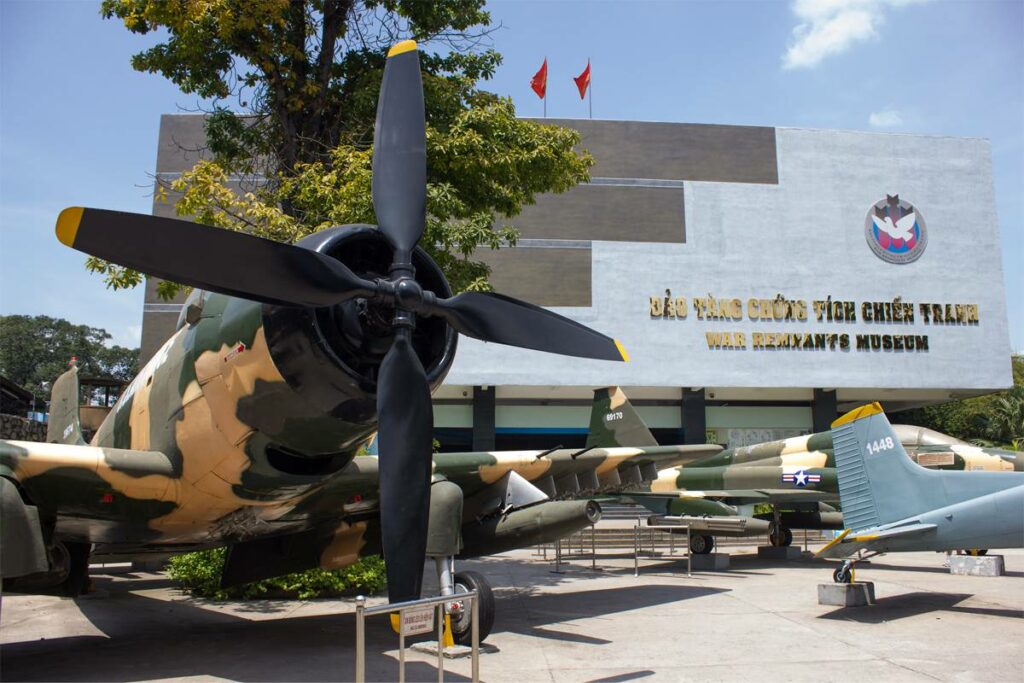
Vietnam’s museums offer a fascinating look into the country’s history, culture, and art. Visit the War Remnants Museum in Ho Chi Minh City, the Vietnam Museum of Ethnology in Hanoi, or the Cham Museum in Da Nang. These museums provide a great way to learn more about Vietnam while staying dry.
13. Relaxing in coffee shops
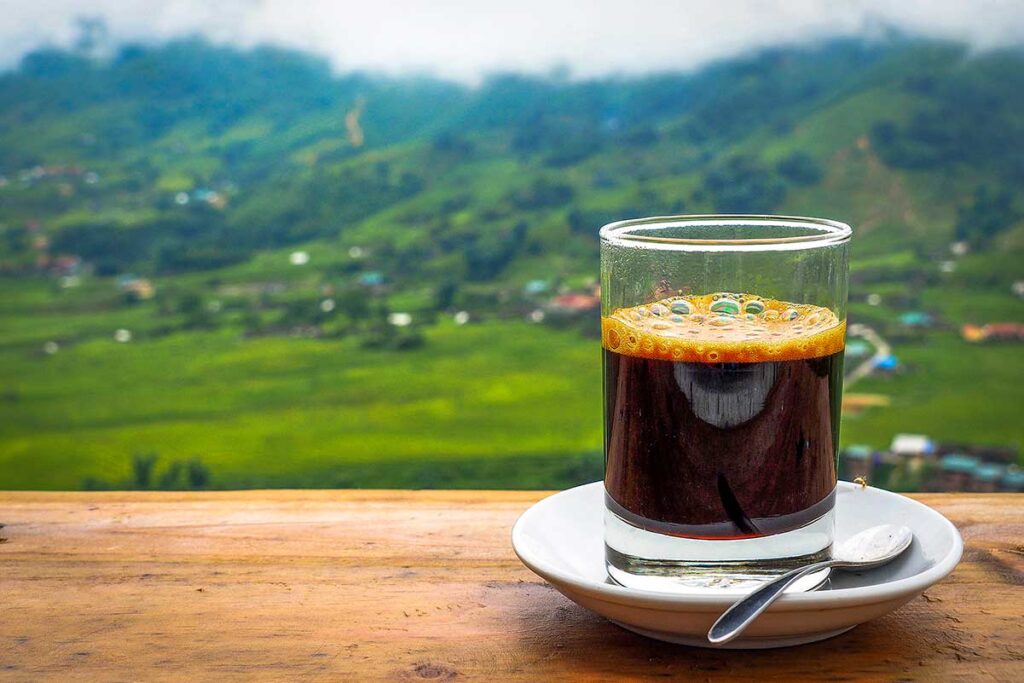
Vietnam has a vibrant coffee shop culture. Locals often visit coffee shops to relax and socialize, especially on rainy days. Many coffee shops offer amazing views, like those in Sapa and Ninh Binh overlooking rice fields, or in Hanoi and Ho Chi Minh City where you can watch street life. Enjoy a cup of Vietnamese coffee and soak in the atmosphere.
14. Indulge in a Relaxing Massage
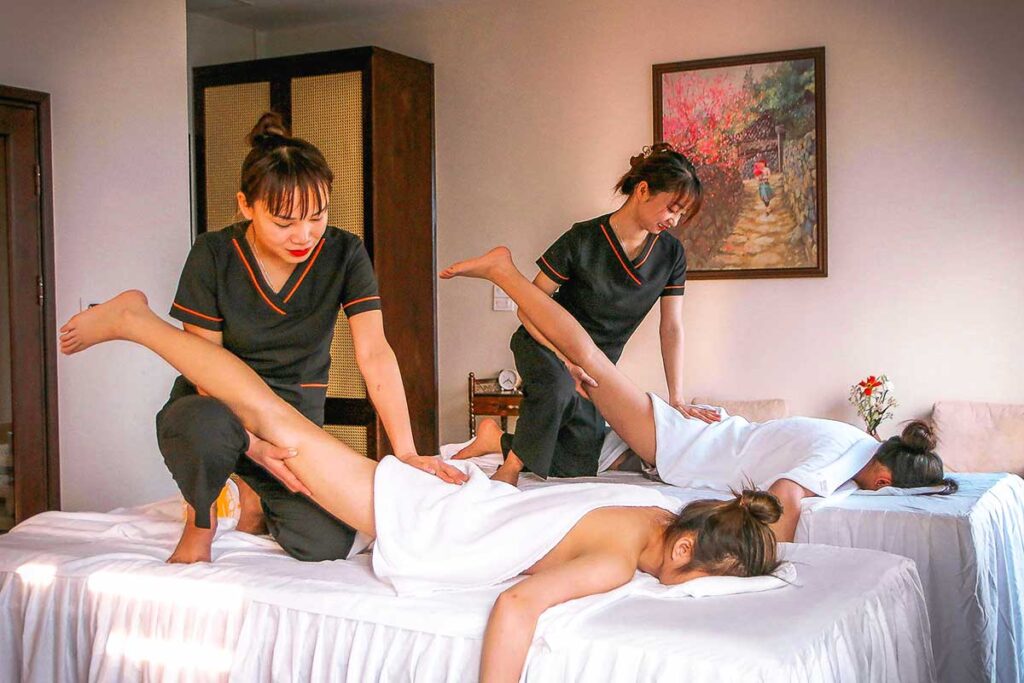
A massage is a perfect way to unwind and escape the rain. Vietnam has numerous spas offering traditional Vietnamese massages, providing a soothing and rejuvenating experience.
15. Vietnamese Cooking Class
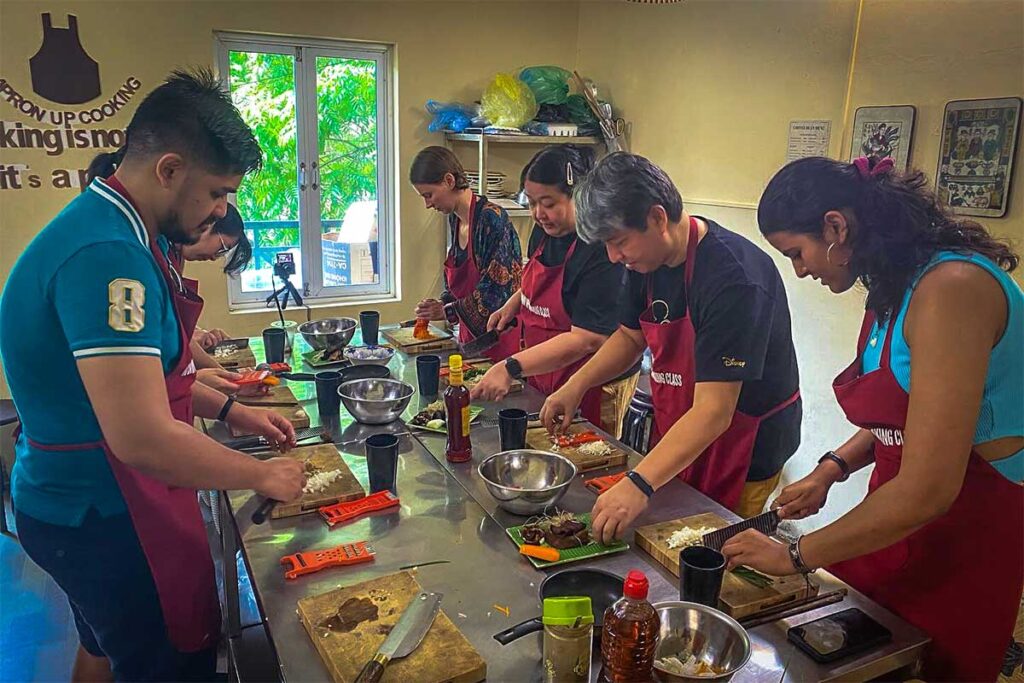
Taking a Vietnamese cooking class is a fun and interactive way to spend a rainy day. Learn to cook traditional dishes like pho, spring rolls, and banh xeo from local chefs. It’s a great way to immerse yourself in Vietnamese culture and bring home some new culinary skills.
16. Indoor markets for shopping or local life
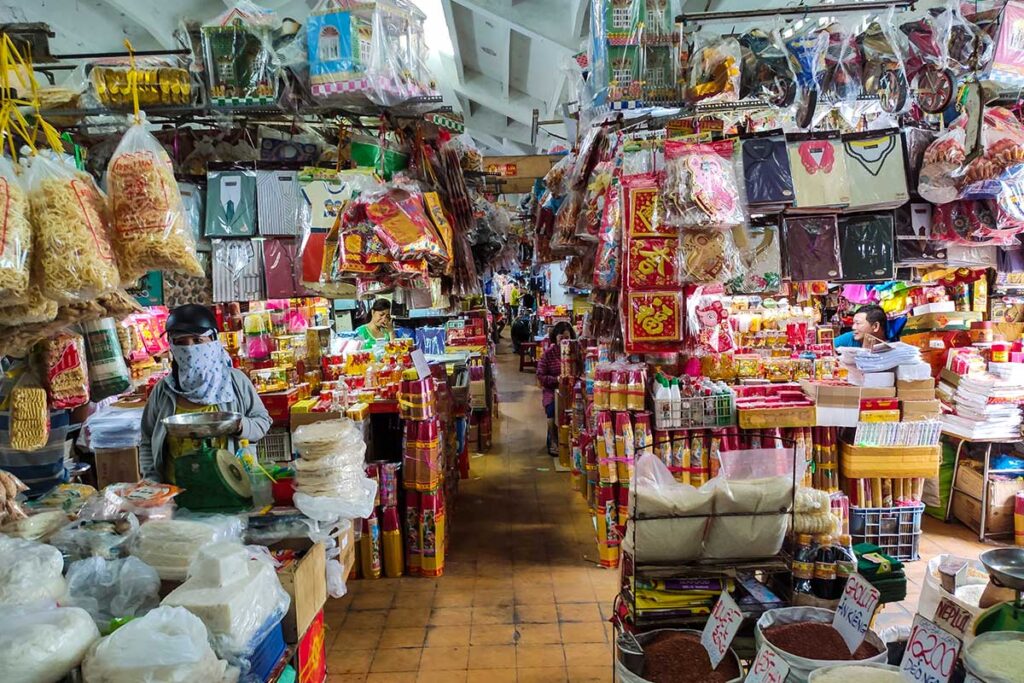
Indoor markets like Ben Thanh Market in Ho Chi Minh City offer great opportunities for souvenir shopping. For a more local experience, visit markets like Binh Thanh Market in Ho Chi Minh City or Dong Xuan Market in Hanoi. These markets provide a fascinating look at local life and culture, even if you’re not into shopping.
17. Enjoying a traditional Vietnamese show

Traditional Vietnamese shows are a great way to immerse yourself in the culture. In Hanoi, you can enjoy a water puppet show, a unique art form that dates back to the 11th century. In Ho Chi Minh City, the Opera House hosts various performances, including traditional music and dance. In Hoi An, the Lune Production offers stunning shows combining acrobatics, dance, and folk music.
Traveling with Local Vietnam during rainy season
Traveling during the rainy season in Vietnam can be an amazing experience, with stunning rice fields and nature, clean air, and fewer tourists. However, you may feel that you have to take too many things into account, and the different regions with each their own weather can be confusing. At Local Vietnam, we can offer you peace of mind by guiding the planning in advance and also helping you during your trip.
What does that mean?
- Customized travel plan: We create personalized travel plans that cater to your interests while ensuring they are suitable for the rainy season.
- Free Vietnamese SIM card: Upon arrival, you will receive a free Vietnamese SIM card so that you can always stay in touch with us via WhatsApp. If something needs to be adjusted, we are there for you immediately.
- Expert local support: Our experienced team understands the nuances of Vietnam’s weather patterns and can quickly adapt your itinerary if unexpected situations arise, such as a canceled cruise due to weather or flooding.
FAQ about rain season in Vietnam
When is the rainy season in Vietnam?
Vietnam’s rainy season varies by region:
Northern Vietnam: May to October (heaviest in July and August)
Central Vietnam: September to January (heaviest in October and November)
Southern Vietnam: May to November (heaviest in June and July)
Does it rain all day during the rainy season?
No, it doesn’t rain continuously. You can expect short, intense downpours, often in the afternoon, followed by clear skies.
Is it still hot during the rainy season?
Yes, temperatures remain warm throughout the country, even during the rainy season.
North: 25°C – 30°C (77°F – 86°F)
Central: 20°C – 28°C (68°F – 82°F)
South: 26°C – 32°C (79°F – 90°F)
Can I still visit the beach during the rainy season?
While swimming and sunbathing might not be ideal, you can still enjoy walks and photography on the beaches. If you’re looking for beach weather during June, July, and August, head to Central Vietnam.
Is it safe to travel during the rainy season?
Generally, yes. However, be aware of the increased risk of landslides in mountainous areas and flooding in cities.
Is the rainy season a good time to visit Vietnam’s rice fields?
Yes, the rainy season is the best time to see the rice fields in their full green glory, especially in regions like Sapa and Mu Cang Chai.
Is it cheaper to travel to Vietnam during the rainy season?
Yes, traveling during the rainy season can be cheaper as many hotels and tours offer discounts.
